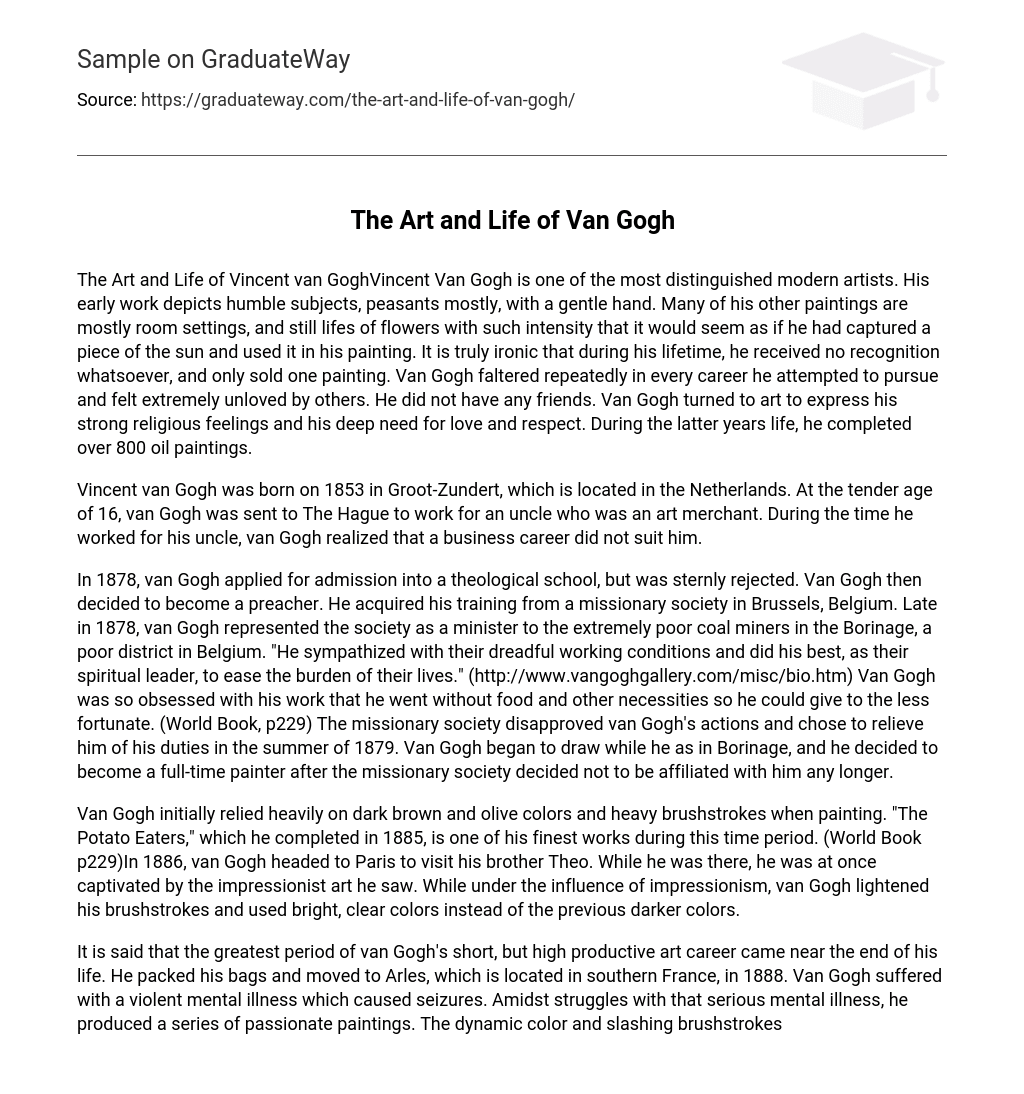Vincent Van Gogh, a highly regarded modern artist, portrayed humble subjects, primarily peasants, with a delicate touch in his early work. Additionally, he depicted room settings and still lifes of flowers with such intensity that it appeared as if he had captured a fragment of the sun to incorporate into his paintings. It is ironic that despite his immense talent, Van Gogh did not receive any recognition and only managed to sell one painting during his lifetime. Throughout his various career attempts, he faced numerous setbacks and felt profoundly unloved by others, lacking any close friendships. Van Gogh turned to art as a means to convey his fervent religious beliefs and intense desire for love and respect. In his later years, he produced over 800 oil paintings.
Vincent van Gogh, born in 1853 in Groot-Zundert, Netherlands, was sent to The Hague at 16 to work for his art merchant uncle. However, he quickly discovered that a business career was not his calling.
In 1878, Vincent van Gogh applied for admission into a theological school, but was harshly rejected. Undeterred, van Gogh resolved to become a preacher and received training from a missionary society in Brussels, Belgium. Towards the end of 1878, he served as a minister for the destitute coal miners in the impoverished Borinage district of Belgium. During this time, van Gogh empathized with their abhorrent working conditions and, as their spiritual leader, made earnest efforts to alleviate their hardships. According to sources, he even sacrificed his own basic necessities to tirelessly assist those less fortunate. However, the missionary society disapproved of van Gogh’s actions and dismissed him from his responsibilities in the summer of 1879. Van Gogh’s experience in Borinage prompted his interest in drawing, leading him to pursue a career as a full-time painter after severing ties with the missionary society.
Van Gogh’s early paintings were characterized by the use of dark brown and olive colors, as well as heavy brushstrokes. A notable masterpiece from this time is “The Potato Eaters,” finished in 1885 (World Book p229). In 1886, he traveled to Paris to visit his brother Theo where he became captivated by impressionist art. Consequently, Van Gogh started employing lighter brushstrokes and vibrant, vivid colors instead of his previous darker palette.
According to reports, Van Gogh had a significant period of artistic accomplishment towards the end of his life. In 1888, he relocated to Arles in southern France and produced intense paintings that reflected his agitated state of mind resulting from severe mental illness and seizures. One notable example is “The Night Cafe,” which meticulously captures turbulence. Another haunting artwork is his self-portrait from January 1889, depicting his head still bandaged after self-harm during a seizure. Despite using limited colors, the painting bursts with energy through countless brushstrokes of true color. The troubled eyes on the face remain the focal point and elicit attention and empathy.
During this time, van Gogh even threatened Paul Gauguin’s life when he visited in 1888 (Source: http://www.hearts-ease.org/gallery/19th-c/post-impressionist/vangogh/bio.html). Shortly after this incident, van Gogh was admitted to Saint-Remy insane asylum where he continued painting during periods of mental instability until the end of his life. Dr.Paul-Ferdinand Gachet provided treatment for him at Saint-Remy;he was an artist himself and an early supporter of impressionist painters.
Van Gogh is widely acknowledged as one of history’s most exceptional artists.Despite van Gogh’s limited productive days, he possessed the talent to create a masterpiece within a single day when he was in a clear-minded and healthy state. Unfortunately, his tragic death in 1890 leaves us pondering the untapped artistic potential that could have been achieved if he hadn’t met such an abrupt end.
Bibliography: Works Cited
“The Vincent van Gogh Gallery,” http://www.vangoghgallery.com/misc/bio.htm. 25 March 2001.
The World Book Encyclopedia – World Book Encyclopedia, Inc. – “V” 1991.
“Vincent van Gogh,” http://www.hearts-ease.org/gallery/19th-c/post-impressionist/vangogh/bio.html. 20 March 2001.





